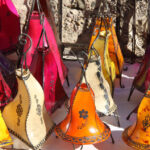CTRL+K
CTRL+K
Dinanderie is skillful metalwork made from copper, brass, silver, and other metals. This artistry has a long history in Morocco, starting in the 12th century. By the 14th century, it became a renowned specialty. We’ll explore the appeal and expertise of Dinanderie. We’ll discuss its growth over time, metalworking methods used, and its importance in different regions especially the respected Tiznit craft.
The Moroccan Dinanderie is a special craft that has been around for many years. It is made by skilled artisans called Maâllems. These Maâllems are master craftsmen who have learned their skills from their parents and grandparents. To make Dinanderie objects, the Maâllems first melt metal. Then, they use hammers, chisels, and other tools to carefully shape the melted metal into beautiful objects. These objects can include intricately patterned tea trays called ‘Soigni’, ornate teapots, candle holders, and copper fountains. The Maâllems take great care and pride in their work. Every piece they create shows their deep respect for the traditional techniques and their attention to every little detail to make it special and unique.
Moroccan Dinanderie, which means metalwork, is a very important part of Moroccan culture, which is used for everyday items like plates, pots, and lamps, but it is also a symbol of Morocco’s history and traditions. Moreover, in Moroccan homes, Dinanderie items are not just ordinary objects – they are special heirlooms that are passed down from parents to children for many generations. These beautiful metal items are used to decorate homes during special celebrations like weddings or religious holidays. They show the Moroccan values of welcoming guests and being generous and friendly. But Dinanderie is more than just decorations – it also helps keep alive the traditional ways of making things by hand that have been used in Morocco for hundreds of years. Even as the world changes quickly, Moroccan artisans continue to make Dinanderie pieces using the same ancient techniques that their ancestors used long ago. This helps Moroccans feel proud of their rich cultural heritage and preserve these important skills for future generations.
Dinanderie, the art of metalworking, is found all over Morocco, but certain regions have become famous for specific styles and designs. One of these regions is Tiznit, located in the southern part of the country. The artisans in Tiznit create metalwork with a distinct regional character. They take inspiration from the local landscapes, Berber traditions, and materials found in the area. The result is a stunning collection of rural, handmade items, including the iconic ‘Tikinte’ pot. This pot is a treasured item in every traditional home in the Tiznit region. Other cities and towns in Morocco also have their own unique interpretations of Dinanderie. Each place adds its own special touch to the rich tradition of Moroccan metalworking. The artisans in different regions use diverse techniques, designs, and materials to create beautiful pieces.
During the past few years, there have been efforts to protect and encourage Moroccan Dinanderie as a significant part of the nation’s cultural legacy. Artisan groups and government programs aim to provide assistance and training to aspiring craftspeople. This ensures that this ancient tradition continues to flourish in the present era. Furthermore, initiatives focused on raising consciousness both locally and internationally help showcase the exquisite beauty and skilled craftsmanship of Moroccan Dinanderie. These endeavors further solidify its status as a cherished national treasure beloved by all.





































There are no results matching your search.
Reset